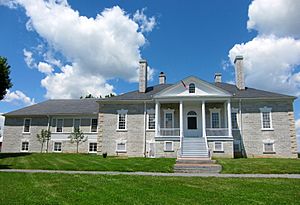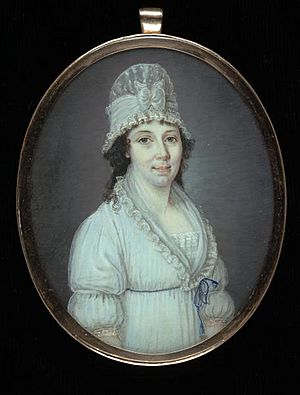Mary Briscoe Baldwin facts for kids
Mary Briscoe Baldwin (born May 20, 1811 – died June 20, 1877) was an American teacher and missionary in the 1800s. She traveled far from home to help people in Greece and Jaffa (which was also called Joppa). She was special because she was the first single woman sent out by the American Protestant Episcopal Church's mission board. During the Crimean War, Mary Baldwin even worked with the famous nurse Florence Nightingale in hospitals, and they became good friends.
Contents
Early Life and Learning
Mary Briscoe Baldwin was born on May 20, 1811, at a large home called Belle Grove in Frederick County, Virginia. This beautiful mansion was in the Shenandoah Valley and belonged to her grandfather.
Her father was Dr. Cornelius Baldwin, and her mother was Nelly Conway Hite. Nelly was also the niece of James Madison, who was the fourth President of the United States. Mary was one of twelve children in her family.
All the children in Mary's family were taught by private tutors at home. Mary was a very independent thinker and liked to form her own ideas about everything she learned.
A relative named Bishop William Meade from the Protestant Episcopal Church was very important in her religious life. Mary's faith was strongly tested when her parents passed away and her family home broke up.
Becoming a Missionary
When Mary was about 20 years old, she visited relatives in Staunton, Virginia. After a year there, she felt tired of the usual social life. She really wanted to do something meaningful for others.
Mary felt a strong desire to help spread Christian teachings. Since women could not become ministers, she thought about becoming a missionary. She felt this was a very important and special job.
Mary realized her education wasn't complete for this big goal. So, she enrolled in Miss Sheffy's boarding school in Staunton. After two terms, she was offered a job as an assistant teacher there, which she accepted.
Going to Greece
While teaching, Mary asked if there was a chance for a single woman to work as a missionary in another country. The Protestant Episcopal Society received a letter from Mrs. Hill in Athens, Greece. Mrs. Hill urgently needed help with the schools she had started there.
Mary knew Mrs. Hill a little, so she was very interested in this work. After thinking about it for a long time, she decided, "I will go!" Mary was one of the first unmarried missionaries to leave America.
Some of her friends were surprised by her decision. They thought she was being foolish or "throwing herself away." But Mary didn't let their opinions stop her. She started preparing right away, visiting her old home and other places.
Mary didn't join the mission for money; her salary was only $250. She was even willing to use her own money to help with expenses.
Life in Athens
Mary arrived in Greece in the summer of 1835. She was excited to live in a land with so much history. Many poor people in Greece were struggling because of harsh rule and taxes. Missionaries had to help them with both their physical needs and their spiritual needs.
Mary understood this and worked hard to help everyone. Dr. and Mrs. Hill, who ran the school, were very happy to have her. Mary took charge of the sewing department.
The girls loved her, and their parents respected her. Learning to sew helped the girls earn a living. After Greece became independent, many tailors and dressmakers came to Athens. They needed girls who could sew, and the only ones who knew how were Mary's students.
This skill greatly helped poor families. Mary became known as "Good Lady Mary" among the local people. When she walked in the streets, people would show her great respect. This made it easier for her to share Christian teachings.
Mary's main goal was to help Greek girls become good daughters, wives, and mothers. She had about 350 children in her care. She also trained many girls from wealthier families to become teachers themselves. These teachers then worked with Greek and Turkish women, spreading Mary's positive influence.
After working for eleven years, Mary needed a break. She traveled through Italy and then Greece, but she still didn't feel better. She returned to the United States for a year.
Starting a Boarding School
After her visit home, Mary returned to Greece with her sister. Together, they started a boarding school for older girls in Athens. This school was connected to Mrs. Hill's day school.
Mary used a lot of her own money to make this school a success. Because of her efforts, she is seen as the founder of Christian education for girls in Greece.
In 1866, Christians in Crete rebelled against the Turkish government. Many poor Cretans fled to Athens. Mary worked with these refugees for over two years. She started day schools and Sunday schools for them. She also fed the hungry and gave women and girls materials to sew and knit, providing jobs for hundreds.
After 33 years in Greece, Mary felt her work there was done as the Cretans returned home. She asked the Missionary Committee to move her to Jaffa (the ancient city of Joppa). Her nephew had been appointed consul there.
Moving to Jaffa
The transfer was approved, and in 1869, Mary moved to Jaffa. She lived with her sister, Ann Maury Hay, and her nephew, John Baldwin Hay. She helped in the Protestant schools there.
Mary worked with Miss Arnott, a Scottish woman who ran a girls' school. Jaffa was a new and exciting place to work, with people from Jewish, Greek Christian, and Muslim backgrounds. Mary had often dreamed of working in Palestine.
Challenges and Return Home
Mary's eyesight began to fail, so she had to leave Miss Arnott's school. After some rest and medical care, she decided to start a boys' school. She needed money to build a school building.
So, in 1872, after 25 years away, Mary returned to the United States to raise funds. While visiting a church, she fell and was badly injured. From that day until her death, she was almost always in pain.
Later Years and Legacy
Despite her pain, Mary returned to Jaffa to continue her work. She was very happy to be back in Palestine. She passed away on June 21, 1877, after 42 years of service as a missionary.
Mary Briscoe Baldwin was buried in the English cemetery in Jaffa. Her friends placed a tombstone of Greek marble over her grave. The inscription on it read: "There is no difference between the Jew and the Greek: for the same Lord over all is rich unto all that call upon him."
After Mary Baldwin's death, the Joppa Mission School was renamed the Mary Baldwin Memorial School in her honor.
|




